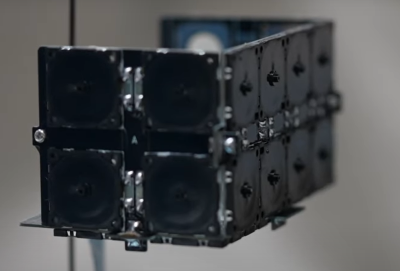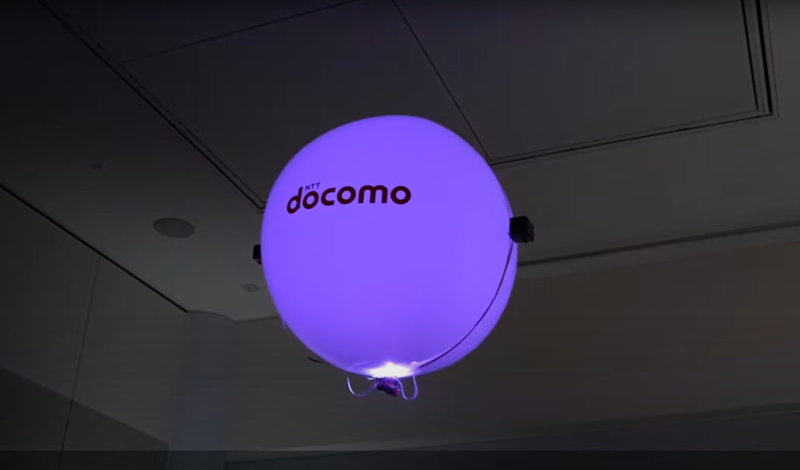Quadcopter type drones can be flown indoors, but unless you have a lot of space, it usually just ends in a crash. The prospect of being hit in the face by the propellor blades, spinning at 10k RPM doesn’t bear thinking about, and then there’s the noise. So, as a solution for indoor photography, or operating in public spaces, they are not viable. Japanese mobile operator DOCOMO has a new take on an old idea; the blimp. But, surely even a helium filled vehicle needs blades to steer around the room, we hear you cry? Not so, if you use a pair of specialised ultrasonic transducer arrays to move the air instead! (Video, embedded below)

Details are scarce, but DOCOMO have fitted a helium balloon with modules on either side that can produce a steerable thrust, allowing the vehicle to effect all the expected aerial manoeuvres with ease and grace. The module at the bottom contains the control electronics, an upwards facing RGB LED for some extra bling, and of course a video camera to capture those all-important video shots.
We’d love to find a source for those ultrasonic transducer devices, and can only guess at the physical arrangement that allows for air to pass in one direction only, to effect a net thrust. We can find a few research papers hinting at the ability to use ultrasound to propel through air, like this one (bah! IEEExplore Paywall!) but to our knowledge, this technology is not quite in the hands of hackers just yet.
Blimps are by no means scarce on these fine pages, here is a Blimpduino, an Arduino controlled 3D printed blimp, an illuminated blimp art installation by Japanese artist [Kensho Miyoshi] and if using helium is just too darn safe for you (or if you want to help prevent this allegedly precious resource from being lost into space) you could just build a remote controlled blimp using hydrogen instead. Just don’t light a match.
Thanks [Itay] for the tip!

















I scavenged ultrasonic transducers from dollar-store air humidifiers (I needed to mimic human breathing cycles for a medical project)
“Usually a transducer converts a signal in one form of energy to a signal in another.” (https://en.wikipedia.org/wiki/Transducer)
These look like Murata microblowers. They have been featured a few times before. You could probably find that with a search ;-)
They are indeed murata microblowers, a little google-fu let met this article with all te details: https://www.nttdocomo.co.jp/english/binary/pdf/corporate/technology/rd/technical_journal/bn/vol21_4/vol21_4_006en.pdf
It would be fun to make an eyeball blimp and then fly around ;)
Yes. I did eventually find a post from 2014 once I new what to search for.
These murata parts look like the ones.
Neat.
Noting this, I’m reminded of Disney’s vortex generator for haptic feedback https://hackaday.com/2013/07/29/disney-prototype-adds-haptic-feedback-to-gestural-interface/
“The prospect of being hit in the face by the propellor blades, spinning at 10k RPM doesn’t bare thinking about”
It doesn’t bear thinking about even with ones’ clothes on!
Ah, side-effect of the work-at-home trend.
Darnit. I always make that typo. I just can’t bear it. Fixed.
I wonder how dogs (and other animals) will react…
Or even younger people who can hear harmonics. But i suppose in a sports venue hearing is optional
sounds kinda intense in the first part of the video already ouchh
Yeah, I’ve looked into the ultrasonic speakers arrays, which can focus sound on a single person. They work using very loud (IIRC 140dB or so) ultrasound that interferes to create audible frequencies near/on the person. But, AFAIK there is some question about whether those are safe/could cause heating damage, so I decided not to mess with them.
The thrusters are Murata Microblowers, part number MZB1001T02, you can buy them on Digikey but they’re expensive and out of stock. They are incredibly inefficient and they’re meant for going inside small electronics. These guys could have just used a fan and saved a few hundred bucks.
This is a stupid idea and a waste of time and money.
Although I see your point here, I wouldn’t call it stupid. Perhaps a bit too far ahead of it’s time.
I don’t get the argument of the dangerous propeller blades though, considering that these can be shielded with a duct and/ or mesh structure around it. This doesn’t need to be heavy. Sticking the fan on the sides of the balloon is easy, but what if the balloon was like a series of stacked doughnuts and the fan was to be placed in the center.
Sure, but there would be a delay and normally there is a thrust curve. The microblower has binay states and is very fast. But I got your point.
Althogh there are more powerfull microblowers also from murata which has way more pressure (but less flowrate). I didn’t get the point of such a large array which, indeed, is probably a waste of money.
And as fas as I know, they all need to have their own circuit. You can’t just put them in parallel because of the freq.
le hackaday moment
I wondered if it would be affected by HVAC air flow?
The paper linked focuses on controlling direction and doesn’t talk much about how propulsion is supposed to happen. Googling for acoustic streaming seems more helpful.
If I get it correctly, the transducer focuses the sound so that at the center it is intense enough for the air’s nonlinearity to rectify it.
About the IEEE paywall, there’s this website.
https://sci-hub.st/https://ieeexplore.ieee.org/document/8580114
That Murata microblower might use ultrasonic frequency piezo elements, but it is entirely unlike the devices presented in the linked IEEE paper.
The microblower is a diaphragm air pump driven by a piezo element. By adjusting dimensions of the device you can tune it for various impedances (pressure vs volume flow rate), like adjusting the specific impulse of a rocket or the pitch and size of a propeller.
The IEEE article (and similar methods) exploits the phenomenon of radiation pressure, an entirely difference mechanism of action.
Radiation force is just emitted power divided by the speed of propagation in the medium. It’s what makes ultrasonic levitation possible. (and radiation pressure is that force divided by the area it’s acting upon).
Radiation force is a gold-standard method of measuring acoustic power output of (for example) medical ultrasound transducers.
In air, a kilowatt of sound will produce a force of 1000 W / 330 m/s. = 3 newtons.
Dimensionally, a watt is a Joule/second is a newton-meter per second. Aren’t SI units convenient?
In water, that same kilowatt will produce a force of 0.7 newtons.
If you’re using light instead, a kilowatt will yield just 3.3 micronewtons.
Your equation is missing speaker area, and air density.
Forexample, one square meter speaker moved by one meter at one second, pushes qubic meter of air, density of air at sea level is ~ 1 kg per qubic meter, and 1 kg is ~ 10 newtons, 10 W = 1 m * 10 N.
This piezo speakers just push air molecules, larger area of piezo compres air to exit smaller nozzle, faster than piezo moves.
No. My equation is correct. Radiation force depends only on emitted power and speed of propagation in the medium. Emitter (speaker) area and air density are not relevant at all.
Seconding Paul here. This is not first principle stuff here. Try your hand at some google-fu before replying about technical topics. Radiation force is a very fascinating topic.
Yes i was wrong, and i made mistake writing equation, crorrect is from wiki, Watt = {[(thrust in newtons)^3]/[4*(density in kg/m^3)*Area]}^0.5 .
Searched for radiation force, and wikipedia and many pages give equations with Area that radiation force is exerting on, if i asume 1 square meter object that is receiving this 1 kW radiation then your equation is correct. Without area it not make sense in real world.
Of course it make sense “in the real world” if you understand what’s actually happening.
You’re conflating pressure and force. They are different things!
There’s no point in even discussing it if you can’t get the dimensional analysis correct yourself. It’s not hard. Just pay attention.
It’s not wise to quote wikipedia pages out of context. It makes you look like you don’t understand the topic.
Sorry for wasting your time, now i understand, i confused that force must be on specific area, and that is Pascal, lesson learned, thank You.